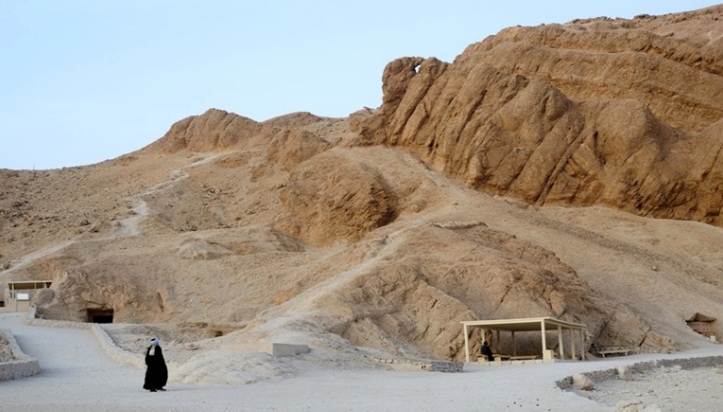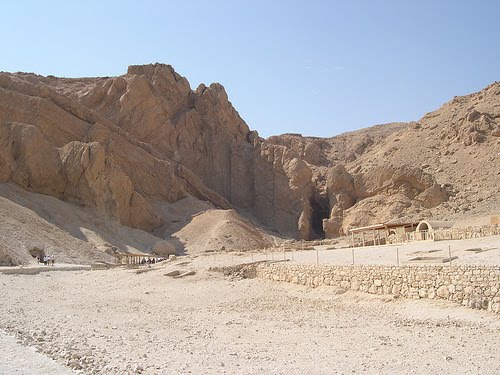Valley of the Queens | Discover the Beauty and Eternal Legacy of Egypt’s Royal Women
Nestled in the arid cliffs of Luxor’s West Bank, across from the lush green banks of the Nile, lies one of Egypt’s most enchanting and historically meaningful burial sites — the Valley of the Queens. Known in ancient times as Ta-Set-Neferu, meaning “The Place of Beauty”, this necropolis was the final resting place for royal wives, princesses, and children during Egypt’s New Kingdom, mainly from the 18th to 20th Dynasties (circa 1550–1070 BCE). Unlike the more famous Valley of the Kings, which served as the eternal home for male pharaohs, the Valley of the Queens reflects the elegance, dignity, and honor granted to elite royal women.
With over 75 tombs discovered to date, including the world-renowned Tomb of Queen Nefertari, this serene desert valley offers travelers a rare opportunity to step into the world of royal women who held immense power, grace, and influence. It is a masterpiece of artistry, symbolism, and funerary tradition, showcasing some of ancient Egypt’s finest examples of wall paintings and architectural sophistication.
In this comprehensive travel guide, you will discover the history, significance, layout, top tombs, excavation history, and everything you need to know for an unforgettable visit to the Valley of the Queens.
Historical Background
The Valley of the Queens was chosen as the burial site for royal women during the New Kingdom, particularly from the reign of Thutmose I onward. Yet, it reached its greatest prominence under Ramses II, who commissioned the creation of QV66, the tomb of his beloved Great Royal Wife, Queen Nefertari. The area was carefully selected due to the nearby sacred site dedicated to Hathor — goddess of motherhood, love, and beauty, as well as Mertseger, protector of the necropolis.
Ancient Egyptians believed that carefully preparing the tomb ensured the deceased’s safe journey into eternity. Like the kings, royalty were buried with treasures, inscriptions, and symbolic depictions of their life and divine status. However, most queens’ tombs were less complex structurally but were often richly decorated, focusing on grace rather than grandeur.
Why the Valley of the Queens Was Important
-
It honored royal women, acknowledging their religious and political influence.
-
Many tombs reflect beliefs in gods like Hathor and Osiris, emphasizing rebirth.
-
The valley was strategically located near the Valley of the Kings, showing women's connection to pharaohs.
-
It preserved the memory of royal family members who played vital roles in court, diplomacy, and rituals.
Notable Tombs in the Valley of the Queens
While many tombs are modest, a few stand out for their architectural and artistic quality.
1. Tomb of Queen Nefertari (QV66)
The most spectacular tomb in the valley — and arguably the most beautiful in Egypt — is the Tomb of Nefertari, wife of Ramses II. Often described as the “Sistine Chapel of Ancient Egypt”, this tomb features:
-
Vividly preserved wall paintings depicting Nefertari’s journey to the afterlife.
-
Iconic scenes of her playing the ancient game of Senet.
-
Beautiful inscriptions and symbols associated with Hathor and Isis.
-
Brilliant reds, blues, and gold tones that remain vibrantly intact after 3,200 years.
Due to its fragility, access is limited and requires a special entry ticket, but it is considered worth every moment.
2. Tomb of Prince Khaemwaset (QV44)
Son of Ramses III, Khaemwaset was a royal child whose tomb is beautifully decorated and shows detailed funerary rituals.
3. Tomb of Amun-her-khepeshef (QV55)
Another son of Ramses III, his tomb showcases artistic depictions of his journey into the afterlife and scenes with deities from the Book of the Dead.
4. Tomb of Queen Titi (QV52)
Believed to be a lesser queen or royal relative, her tomb features colorful religious iconography.
Archaeological Discoveries and Research
The Valley of the Queens was first documented during the Napoleonic Expedition (1799–1802). However, detailed excavations were conducted in the early 20th century by Italian archaeologist Ernesto Schiaparelli, who discovered Nefertari’s tomb in 1904.
Subsequent excavations revealed dozens of tombs, but many were looted in antiquity. Fortunately, wall paintings survived, offering invaluable insight into beliefs, rituals, and artistic practices. Modern conservation efforts led by Egypt’s Supreme Council of Antiquities and international teams, especially in the 1980s, helped restore Nefertari’s tomb.

Architecture and Design
Tombs in the Valley of the Queens typically consist of:
-
A short entrance corridor
-
A burial chamber decorated with mythological scenes
-
A sarcophagus niche
The focus is less on architectural complexity and more on symbolism, harmony, feminine elegance, and divine association.
Religious Symbolism and Meaning
Key religious concepts reflected in the tombs include:
-
Hathor welcoming the queen as her daughter
-
Osiris representing the hope for resurrection
-
The Book of Gates, guiding the soul through the night
-
The goddess Nut, symbol of the heavens, embracing the deceased
The queens were often depicted as children of the gods, reinforcing their divine legitimacy and eternal life.
How to Visit the Valley of the Queens
???? Location
On the West Bank of Luxor, close to the Valley of the Kings and Hatshepsut Temple.
???? Opening Hours
-
6:00 AM – 5:00 PM in winter
-
6:00 AM – 6:00 PM in summer
???? Ticket Information
-
General Valley access: approx. EGP 100 (subject to change)
-
Tomb of Nefertari: approx. EGP 1,600 per person — limited entry, often needs advance booking.
???? Best Time to Visit
October to April, early morning to avoid heat and crowds.
What to Expect During Your Visit
✔ Peaceful surroundings and breathtaking desert landscape
✔ Limited visitors at Nefertari’s tomb ensure a serene experience
✔ Detailed archaeological signage explaining key tombs
✔ Beautiful photography opportunities (depending on regulations)
✔ Guided tours available via professional operators
Tips for Travelers
-
Book entry for Nefertari’s tomb early — spots fill quickly.
-
Wear comfortable shoes and sun protection (hat, sunscreen).
-
Bring water, especially in summer.
-
Combine your visit with Valley of the Kings, Hatshepsut Temple, and Medinet Habu.
-
Hire a knowledgeable Egyptologist guide to fully appreciate the symbolism.
Nearby Attractions
???? Valley of the Kings – iconic burial site of pharaohs
???? Mortuary Temple of Hatshepsut – breathtaking terraces
???? Colossi of Memnon – grand entrance statues
???? Medinet Habu Temple – beautifully preserved temple of Ramses III
???? Ramesseum – mortuary temple of Ramses II
Why You Should Visit the Valley of the Queens
-
It offers a more intimate and artistic experience than the Valley of the Kings.
-
The Tomb of Nefertari is one of the most stunning artistic experiences in Egypt.
-
It highlights the role of women in ancient Egyptian dynastic history.
-
A visit here completes your understanding of royal life, heritage, and belief in immortality.
Conclusion
The Valley of the Queens is not just a burial place — it is a tribute to beauty, power, and eternal love. From the breathtaking artistry of Nefertari’s tomb to the serene desert setting, this site brings history to life in a way that few archaeological destinations can.
It is a place where art meets eternity, where every color and carving speaks of devotion, legacy, and the timeless journey of the soul.
???? Call to Action
Don’t miss the chance to experience one of ancient Egypt’s most beautiful and meaningful sites. Visit the Valley of the Queens in Luxor and step into the world of Egypt’s royal women — walk through history and witness the eternal elegance of Queen Nefertari today!



